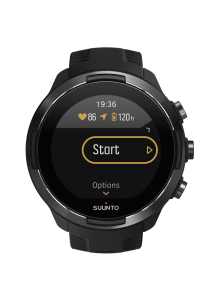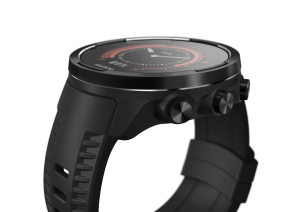New perk! Get after it with local recommendations just for you. Discover nearby events, routes out your door, and hidden gems when you sign up for the Local Running Drop.
Suunto 9 Baro
Price: $600 ($650 with Heart Rate Belt)
Weight: 81 grams/2.85 Ounces

The following is an in-depth review of the Suunto 9 Baro. See below for the quick-and-dirty facts and impressions; read on for more details.
Quick Guide
—Wrist HR Monitor: Valencell Performtek Optical sensor
—Battery: Up to 120 hours on Ultra Mode
—Over 80 preloaded modes
—Custom battery and GPS options
—Updates: Better touch screen, easier menus
Impressions
—App connectivity: User friendly/intuitive
—GPS Accuracy: Excellent
—Third-party app connectivity: somewhat confusing – see below
—Comfort: Excellent (no sharp edges, low profile HR Monitor, relatively comfortable to wear while charging)
Tips
—Update the GPS using Suuntolink app, downloaded to a computer. This will also update the watch’s software. Download the app here.
—The Suunto app will track your fitness; however, it doesn’t seamlessly connect with third-party fitness trackers, like Strava. For that, use Movescount app.
—Movescount is an app and a website, and it is the only way to sync your exercises to third-party fitness trackers like Strava. Make a personal account on the website and make sure you enable Strava (or your preferred fitness tracker), then download the app, connect it to the watch.
—Before you start your exercise, wait until the watch syncs with GPS satellites, which is signified with the green arrow at the top of the screen.
The latest iteration of Suunto watches is the 9, and it is a powerhouse. It sports an incredibly accurate wrist heart-rate monitor, excellent GPS tracking and an astonishing battery life. The S9 Baro is a sleek device weighing less than three ounces and fits equally well in the office as out on the trails.
Many of the updates with this device build on accessibility and customizable options. There are over 80 sport modes pre-programmed, with the option to create custom sport modes for specific activities or goals.
The truly mind-blowing thing about this device, however, is the 120-hour battery (while tracking GPS in Ultra Mode).
The long battery life is due to the intelligent battery. When in exercise mode, competitor devices lock into the battery setting you began with. Suunto understands that sometimes a session takes longer than originally anticipated, (or you’re epic-ing) or you might have forgotten to charge the device recently.

So Suunto programmed the S9 to make adjustments. The intelligent battery will adjust to a lower GPS ping rate and turn off some battery draining features to track the entirety of a session. The watch will also give you warnings when the battery only has a few hours of life left.
The other truly innovative thing about the S9 is the FusedTrack functionality. Essentially, FusedTrack corrects the GPS breadcrumbs to more accurately track your distance, route and speed, while receiving less GPS pings in order to save battery.
The accelerometer gauges your direction on the last ping and links it to the next ping in a more seamless way. For those going out on longer efforts into the most ultra of ultras, the FusedTrack’s benefits will become immediately clear.

It’s important to note that a lot of these features seem geared towards the ultrarunning community, but Suunto designed the S9 with casual athletes and hikers in mind as well. The S9 is jam-packed with some of the highest quality features for athletes of any level.
The S9 has some smartwatch capabilities when linked to a phone through Bluetooth. The features are simple, but more than enough to catch up reading the latest text or screen a phone call. To keep the GPS as accurate as possible, be sure to download SuuntoLink to your computer and plug it in every few weeks.
Keep in mind that to link to Strava or other performance trackers, one needs to download the Movescount app. The Suunto app is elegant and intuitive, but it does not connect to third-party services. One of the coolest features, in Trail Runner’s opinion, is the ability to use and load training plans onto the S9 from the Movescount Website. These plans are found in the community tab.

We reviewed the Suunto S9 Baro (which is different from the Suunto 9; all information above is relevant to both models). This version of the S9 has a few additional features. The Barometer in the S9 gauges air pressure to more accurately detail altitude and elevation gain or descent.
Note, one must regularly calibrate the compass to provide the best information.
This is accessed and updated through the navigation settings. Try to do this before your activity as there is no way to calibrate the barometer in exercise mode. Suunto developed FusedAltiTM as a means of utilizing the best features of GPS altimeter and a barometric pressure sensor. The barometer is quicker to react to changes; however, the GPS is not impacted by drops and rises in pressure due to weather.

Finally, the barometer provides a quick-and-dirty way to pay attention to changes in pressure that might indicate an approaching storm. One can even set a storm alarm, though this is not a replacement for proper planning and risk management. This feature definitely comes in handy in the mountains or when running close to large bodies of open water.
Overall, the S9 has a ton going for it.
The touchscreen is responsive and the menus are intuitive. There is so much customization that truly-inspired people can tinker with, but the S9 comes with over 80 sports modes preloaded onto the device, so it’s pretty much ready right out of the box.
Regular calibration is important for the accuracy of the GPS and barometer, though this does take a moment to do. The benefit of incredibly accurate data offsets the few seconds of arm-swinging required. As an anecdote, a friend running the Tor De Géants, a 205-mile race through the Aosta Valley in Italy, noted that many of the participants had the Suunto S9. He noted that he saw considerably fewer wires from wrists connected to portable chargers.
It is a watch designed for ultra athletes and those looking to record extremely long efforts, but it also considers casual users. Over 99 percent of the time, I’m not racing or running ultra distances. Suunto really took that into consideration: one can work a full-time job and get out for a long run without having to charge all the time.
—Tim Nooney runs 80 miles per week, typically with a new piece of gear that Trail Runner makes him take along and review.